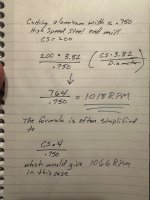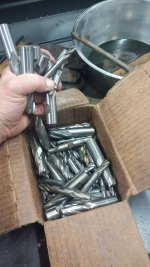Surface finish is trash. The cutter is hooched and I don't know what in the heck I'm doing. Not comfortable at all with the graduations on the handwheels and too cheap to spring for a DRO. Planned out the order of operations in such a way that I could use a dial indicator on a mag base to measure over to my next cut. Nailed every dimension to within 0.001". I'm happy with that!
Since you said you don't know what you're doing and I saw the spindle speed post, I'll offer some general advise for spindle speeds.
Every workpiece material has a surface feet per minute, often called simply cutting speed (SFPM or CS).
If you know that CS, there's a simple formula that can help set your spindle speed. For general shop work you can use some ballpark CS for your materials.
High Carbon/tool steels ~50
Mild steels ~100
Aluminums ~ 200
I'm attaching a pic because formulas don't always type well...

This works for HSS cutters in good condition. If you're using carbide cutters you can get close to tripling the result of that formula depending on the situation (cooling/cutting oil/chip evacuation/etc)
Also, with aluminum I'd recommend using a 2-flute cutter rather than a 4-flute as it will clear chips better and have less tendency to pack up the flutes.
For drilling and milling we're using the diameter of the cutting tool in the formula. If turning a part on a lathe, we're using the diameter of the stock (unless drilling into the end). For reamers, cut the results of the formula in half if you value your reamers!
For insert carbide tooling on a lathe...that formula result * 3 is usually about right. Carbide inserts need a fair depth of cut to work properly too, they are not sharp but instead rip away material via heat and pressure. If you're not generating heat and pressure the insert won't give predictable results.



